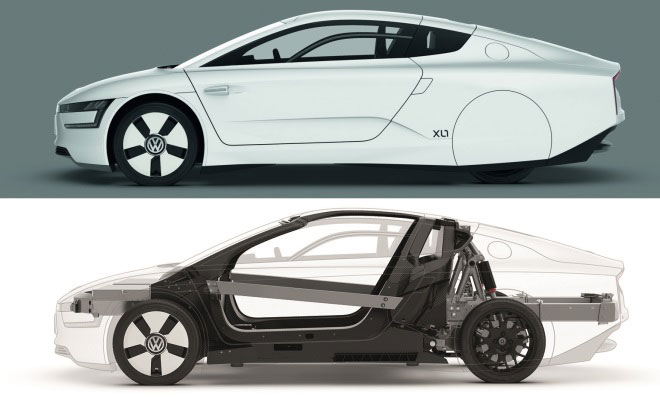
With a drag co-efficient of 0.19, the late and much lamented EV1 electric car is the most wind-cheating vehicle ever to be produced in numbers. But that’s about to change. Ahead of next month’s Geneva show, Volkswagen has confirmed plans to build and sell its XL1, a low-slung slip of a car that boasts a drag factor of just 0.189 – or about a sparrow's breath better than the EV1.
This week Volkswagen has detailed the XL1’s groundbreaking production process in extraordinary detail, but has left out one or two of the most important points in its plan. It hasn’t yet said how many cars it intends to build, at what rate, and most importantly, how much it expects to charge.

On the thorny question of price, my seasoned guess would be “a lot”.
One glance at the XL1’s arresting shape makes it clear how its best-yet Cd figure has been achieved – it resembles few other production cars, aside from the equally futuristic 1999 Honda Insight (which boasted a Cd figure of 0.25).

Even parked next to an Insight, the XL1 will remain distinctly other-worldly. For one thing, it’s tiny – slightly shorter and narrower than the Honda, and a substantial 10cm lower at just 1,153mm. That’s supercar low, midway between the height of a Lamborghini Aventador and Gallardo. The slinky VW will also boast up-and-over doors much like those fitted to the iconic McLaren F1.
At 795kg the XL1 will be substantially lighter than the 852kg Insight, despite delivering modern levels of crash protection.

That low weight is possible because VW won’t let BMW have all the fun trying to put carbon fibre into easily repeatable production. While aluminium is used for front, rear and side impact absorption, the bulk of the car’s structure is carbon, as are the outer panels. The wheels, shod with skinny low-resistance rubber, are made from equally high-tech magnesium – 15 inches across at the front and a 16 at the back. Suspension components like wishbones and anti-roll bars are either carbon fibre or aluminium, while the brake discs are ceramic.
Under the slippery carbon skin VW has installed a plug-in hybrid powertrain, sending drive to the rear wheels via a seven-speed dual-clutch gearbox. A 5.5KWh lithium-ion battery lives under the bonnet, while the engine, electric drive motor and gearbox are mounted snugly behind the XL1’s pair of seats.

The engine is a two-cylinder, 0.8-litre TDI diesel producing 48PS (47bhp), paired with a motor rated at 20kW (27bhp). Working together, they produce up to 51kW (68bhp) and 140Nm of torque. This is where any resemblance to Lamborghinis comes to an abrupt halt, because getting to 62mph will take 12.7 seconds, with v-max capped at 99mph.
The XL1’s engine and motor are separated by a clutch, allowing diesel power to sit dormant while the battery takes care of propulsion. A full charge should be good for about 30 miles, according to VW, while recharging should take a couple of hours from a household socket. In hybrid mode, range from the tiny 10-litre fuel tank should exceed 300 miles, Volkswagen says.

The company adds that the overall consumption figure comes out at 0.9 litres per 100km, slightly better than the one-litre target it set itself at the outset of the XL1 project in 2002. And in old money? That’s 313 miles per imperial gallon.
As a result, the extraordinary XL1 will be just about the cheapest car in the world to keep filled up with diesel. Which will be just as well, as I suspect absolutely everything else about XL1 ownership is set to fall on the pricey side.

Volkswagen will build its ultra-frugal XL1
22 February 2013
Read more about: hybrids plug-in cars Volkswagen



